Sponsored By
ROCK
HARDWARE
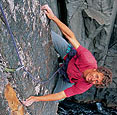
Interview: Simon Mentz
[ More Interviews ]
Date:
10th Aug 2004
Intro: Local reader's will probably best know Simon's name as the
co-author of those outstanding guide books Arapiles Selected Climbs, and
Grampians Selected Climbs. Other's might have come across his name against
numerous starred first ascents that are now considered classics in the
Grampians, Mt Buffalo and deep in the heart of the Northern Territory
where he established one of the hardest routes of the time. Simon's
climbing life has taken him to more distance places like The Nose of El
Capitan and the Matterhorn, but his nucleus remains the appealing country
life of Natimuk where he devotes as much time to the local footy team "The
Rams" as he does towards the
captivating sandstone of Arapiles, just 10 minutes down the road.
| Notable First Ascents | ||||||||||||||||||||||||||||||||||||
|
 My first day of climbing was at
Mt Arapiles with a friend (Ben Galbraith), just after we turned 18 and got
car licences. We had read about Mt Arapiles and decided to drive up and
teach ourselves. We had two short pieces of old sailing rope, a harness
and a set of jumars (?!!). Our first attempt at climbing was Minimus (14)
where we anchored the rope to the top of the cliff and devised a strange
climbing/jumaring system. I came unstuck at the crux bulge when I found
myself greasing out of the finger locks and unable to reposition the jumar
above the knot joining the ropes. I recall my terror when I realised I was
about to fall onto our horrible rope, but fortunately it held.
My first day of climbing was at
Mt Arapiles with a friend (Ben Galbraith), just after we turned 18 and got
car licences. We had read about Mt Arapiles and decided to drive up and
teach ourselves. We had two short pieces of old sailing rope, a harness
and a set of jumars (?!!). Our first attempt at climbing was Minimus (14)
where we anchored the rope to the top of the cliff and devised a strange
climbing/jumaring system. I came unstuck at the crux bulge when I found
myself greasing out of the finger locks and unable to reposition the jumar
above the knot joining the ropes. I recall my terror when I realised I was
about to fall onto our horrible rope, but fortunately it held.
After failing on Minimus we then saw two climbers scramble up to the Bluffs via Alis (2) so we decided to follow them. Alis was pretty scary and we almost turned back, but we eventually pushed through and then watched the two climbers attempt Station to Station (25). The lead climber had a shaved head with a long tuft of hair and was totally ripped. I was amazed by the whole scene, but was a little intimidated by their gnarly appearance to ask questions. Later that evening we spoke to them in the campground. Their names were Chris Peisker and Chris Plant (UK) and they told us they had been living at Arapiles for quite a few months.
The whole scene made a big impression on me and so few weeks later I enrolled on a Victorian Climbing Club trip and did my first lead (D Major, 9). The following weekend Ben and I tagged along with Melbourne Uni on their Easter trip. The leaders on that trip were more interested in teaching the girls than teaching us, so they let us borrow a rope and a rack and do whatever we wanted. I have fantastic memories of thrashing up such classics as Arachnus (9), Pedro (10) and Dracula (11) with Ben and another beginner friend (Cameron Brooks). It was the same year (1986) that top German climber Stefan Glowacz was in Australia and Iíll never forget watching him solo Dramp (21) on the Plaque Area. Later that trip we saw him lead Anxiety Neurosis (26). He stopped at the crux and gave us a little wave. That really made our day!
As for girlsÖ well they were
pretty scarce during my early climbing days. I had no experience with
women, zilcho confidence in meeting women and was too preoccupied with
climbing to even think about women. I was a bit of a late starter in that
department. In later years I think I tried to make up for lost time.
Q: Like myself I understand your start
to climbing had a trad/adventure beginning, something that is perhaps rare
in today's climbing world with the growing abundance of climbing gyms. Do
you feel this initial immersion into the scene influenced your later
style/ethic of climbing?
Although Iím more into trad
climbing, Iíve done my share of working routes, pre-placing gear and
red-pointing (or to be more exact Ďpink-pointingí). But I do feel this
approach kills the mystique of climbs and removes the judgment factor that
has always been such an integral part of being on the sharp end. In my
opinion, 'ground-up' ascents are where it is at with regard skill,
judgement and commitment. That's where you will find, as Glenn Tempest
likes to say, 'magic in the attempt'.
Although rarely practised
nowadays, I believe yo-yoing routes (lowering back to the ground after you
fall and only placing gear on lead from the ground) is a far more
satisfying way to lead trad routes that are just above your onsight level.
Red-pointing, pink-pointing and head-pointing have their place, but I
enjoy the fact that yo-yoing tests your onsight ability every time you
push past your highpoint. If your aim is to climb something without using
the rope for direct assistance then yo-yoing acknowledges the process and
not just the end result. If your focus is simply to link moves which are
at your physical limits, then I donít understand why we donít recognise
top-roping as a legitimate way to climb routes. Iíve been doing more
top-roping lately and Iím thoroughly enjoying it. I canít understand the
rationale of leading a route on pre-placed gear after successfully
top-roping it.
Q: Victorian climbers will be very
familiar with your name given that it's emblazoned next to Glenn Tempest's
on the front cover of the two most sought-after and well presented guides
on offer:
Writing and designing those guidebooks with Glenn has been some of the most rewarding work I have ever done. Itís a dream job producing guides to two of the worldís great climbing areas. I love waxing lyrical about climbs, particularly the easier routes.
As for the amount of work, well
each guide took the best part of a yearÖ drawing maps, creating topos,
quizzing other climbers and poring through old guidebooks and magazines
for historical information. We climbed a huge percentage of the easier and
intermediate routes and abseiled some of the harder ones, so that we could
mark them accurately on our topos. There were a few months of tapping it
all into the computer and coming up with the design. Glenn mastered the
intricacies of desktop publishing and thanks to his expertise the final
results were something we were both proud of. Any sacrifices to our
personal climbing were well worth it.
Q: I believe you're very close to
completing a Melbourne Area guide also with Glenn Tempest. How far off
seeing this on the shelves are we?
Don't hold your breath on seeing
the Melbourne guidebook in the next few months. Although we have done
quite a bit of work, we keep getting sidetracked with other projects. And
because I live in Natimuk, I find it hard to leave Arapiles, drive past
the Grampians and then visit some little cliff near Melbourne (although
some of those little cliffs have some terrific little routes). Iíve been
telling Glenn that maybe he should team up with someone else to finish the
jobÖ like you Chockstone boys.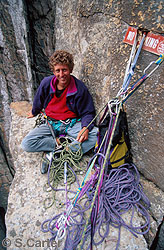
Q: You and Steve Monks managed the first
free ascent of Tasmania's Totem Pole (25), an incredibly wild-looking sea
stack made famous by Simon Carter's
When Steve Monks invited me on the trip (along with Jane Wilkinson and Simon Carter), I jumped at the chance, although I only expected to tag along and second Steve to glory. Whatís interesting is that we almost never did the free route. After reaching the summit via the aid route and doing the tyrolean back to the mainland we almost went home. In fact Steve and Jane did leave because Steve wasnít very confident about the free-climbing possibilities. I thought I had better swing back to the summit and abseil down the other sides of the Totem Pole just to make sure we werenít leaving behind a potential mega-classic. Simon Carter waited for me on the mainland and Iím sure he remembers my whoops of delight when I saw just how climbable it was.
Bolting the line and then
climbing it was pretty much a formality as we had the moves sussed after
checking it in on abseil. Steve had the honours on the first pitch, while
I nabbed the second pitch. I spent a fair bit of time bolting the second
pitch and making sure the clips were okay for shorter folk. I remember
Steve complaining that I was taking too long and faffing around, but I
really wanted to get it right. I could have easily climbed the thing with
half the number of bolts (I ended up placing ten), but I always bolt
things for the ground-up climber. One of my pet-hates is people creating
ridiculously run-out climbs after rap-inspection.
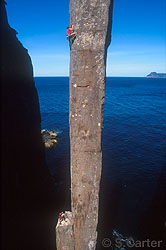
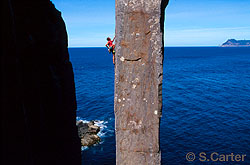
Above: Simon Mentz leading pitch two of
The Free Route (25) on the 65-metre Totem Pole at Cape Hauy, Tasman
Peninsula, Tasmania, Australia. Photos By Simon Carter.
Q: Was free climbing the Totem Pole
something you had thought about much before you visited it with Steve
Monks and Co? How did if feel afterwards? Change your life in any way?
What's it like being a pin-up poster boy?
I was always interested in the idea of free-climbing the Totem Pole ever since I saw a picture of it in Joe Friend's ĎClassic Climbs of Australiaí. I went there earlier with Steve Hamilton, but we failed on the aid route and never returned.
The free ascent of the Totem Pole was certainly a highlight in my climbing career. Not only is the position amazing, but the climbing itself is quite exceptional. However the experience wasn't as intense as some of my ground-up ascents, simply because rap-inspecting and bolting a route removes much of the adventure.
As for being a pin-up boyÖ well
it wasnít the first time I had been in magazines and calendars. It would
be fair to say that I am far better at working photo-shoots than I am at
working routes. Gordon Poultney use to quip that I was Australiaís
best-known bumbly due to the all exposure I received. As a result there
have been some amusing moments at boulders when younger climbers have
recognised me and anticipated some serious cranking. They donít quite know
what to think when they see me fail dismally on the warm-up problems. I
remember the first time I visited the wall at Burnley and was met by a
young Dave Jones who had been trying to link the whole thing. Dave asked
me ĎAre you going to try and flash the whole wall?í Two moves later I was
back on the ground and I think that was as far as I got for the day.
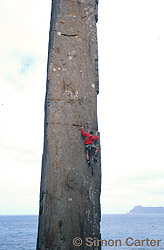
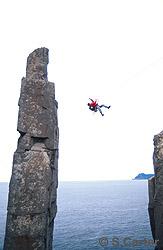
Above: Simon Mentz aid climbing on The Totem Pole in 1995. The aid
route was the only up the 65 metre Pole until Mentz and Monks returned a
few days later and established the Free Route. Photos By Simon Carter.
Q: I found a comment about Central
Australia claiming "annual visits of Simon Mentz, who came up to climb
with Roark Muhlen-Schulte. Together, they were responsible for pushing
Centralian climbing standards with the first ascent of Tjilka (26) in
1992". I also believe there was controversy surrounding the Red Centre's
first sport route (grade 27?). Can you elaborate on the details?
Tjilka is a huge overhanging
line in a limestone cave that Roark discovered. We bolted the hell out of
it and then spent a few days before finally falling up it. I graded it 27
because it seemed steeper and longer than anything else I had been on
(imagine a couple of Procol Harumís stacked on top of each other). However
there are no particularly hard moves and repeat ascents saw the grade
settle at 26. Everyone agrees itís a pretty good route though.
Q: Your ascent of the West Wall of
Serpentine Gorge near Alice Springs was a most audacious on-sight effort.
Can you tell us the tale of this adventure?
The previous year we had investigated Serpentine Gorge and I thought the West Wall looked impossible for a ground-up ascent (we werenít interested in rap-inspecting or rap bolting). However Roark assured me that he had been back and had seen a weakness that we could climb ground-up.
Upon our arrival, Roark pointed out the line and I just laughedÖ ĎWe wonít even get off the ground!í We searched the cliff for other options, but everything looked too loose, too steep, too blankÖ or all three. Roark didnít want to admit that he had made a bad call, so to save face he started up something that looked okay on the first pitch, but which looked horrific on the second pitch (my pitch).
My plan was to make a token
effort at leading the second pitch and then retreat with dignity. As it
turned out, solid holds and good protection kept appearing so I just kept
climbing. We climbed the whole route without falls (pitches of 21, 23 and
18) and were stoked with the quality. The only thing I was disappointed in
was the name we ultimately gave itÖ Pre-nuptial Adventures... itís a
shocker!
Q: It could be said that your ability to
on-sight routes surpasses the grades you tick. Would you say that
on-sighting routes is a strength of yours? Or perhaps a style that you
most prefer?
I am not a very efficient
on-sight climber because I get scared, place masses of gear and am very
slow. But I do have reasonable stamina and when I am inspired about a
particular route I have a fair bit of fight in me and tend to put
everything into my on-sight attempts. Iíve never on-sighted harder than 24
though.
Q: I noticed that some of your first
ascents are continuations or variant of existing routes. In the case of
say Father Oblivion (26) on Taipan which offers a straighter (though
apparently "reachy") conclusion to Sirocco (26), was this a case of seeing
a, possibly better, line that others had missed? Also some others have
requested I ask for the beta on getting past the reachy crux.
The story behind Father Oblivion
was that Andy Pollitt spotted the line and then told me about it. He
thought it would go at grade 24. When I asked why he didnít want to do it,
he replied, ĎI donít want the easiest route on the wall!í It took me a few
days before I finally worked it out (it was harder than 24). And when I
finally did do it, Andy found he couldnít follow it due a massive hangover
from the night before. Given that Andy was always drinking I donít know
why his hangover that morning should have been any different (although he
did cruise the route a few days later).
Extra height helps at the crux, but climbers shorter than me have repeated
it. Iím not quite sure what sequence they use. Youíll have to ask Malcolm
Matheson or Dave Jones.
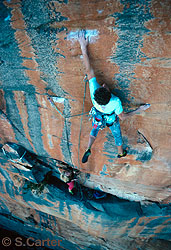
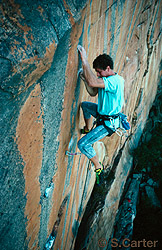
Above: Simon Mentz on his Father
Oblivion (26), Taipan Wall, The Grampians, Victoria, Australia. Photos By
Simon Carter.
Q: Can you tell us a little about some
other FA's such as The Natimuk Route (22) on Frenchmans Cap, Tasmania
(with Steve Monks).
The Natimuk Route was a giant
multi-pitch route that was meant to be a warm-up climb prior to attempting
a direct finish to De Gaules Nose (23). It was the first time Steve and I
had climbed at Frenchmans and from the ground we estimated our Ďfuní
warm-up climb would go at grade 18, not serious 22 which is what it turned
out to be. That climb made me realise that our intended line on DeGaules
Nose was extremely improbable. Despite my reluctance, Steve was still keen
and so we launched up the lineÖ we were spanked!
Q: In Rock 29, you manage to appear in
two separate advertisements (on the same page), endorsing Beal ropes for
Kathmandu in one, and Edelrid ropes for Outdoor Agencies in the other! How
was life as a (presumably?) sponsored climber?
Those were the days. Life as a
sponsored climber was a whirlwind of chicks, drugs, sex, fast cars. Well,
not quite. But my deal with Kathmandu saw me receive some good stuff
(pack, goretex, ropes and other gear). But they made me earn itÖ I had to
appear in some very embarrassing ads. As for EdelridÖ I wasnít even
sponsored by them. They just used the well-known falling shot of me (by
Simon Carter) and implied I was using one of their ropes.
Q: In the mid 1990's you were a frequent
contributor to Rock magazine, in particular you authored a series of
excellent instructional articles for beginners. Was the furthering of the
sport through encouragement of new climbers something you saw as
important?
The instructional articles
myself and Glenn Tempest wrote for Rock were commissioned pieces. I wasnít
trying to encourage others into climbing, but I was happy to point
beginner climbers in the right direction. I actually find writing
instructional articles pretty sterile. I would much rather be writing
guidebooks where I can rave on about climbs, their history and engage in
character assassinations. Thatís a lot more fun.
Q: I'm also led to believe that very few
of your letters were ever published in Rock magazine? What's the story
with that?
Yeah thatís right. There was a
period when I was pretty critical of Rock at times. Its fluoro colours,
clunky design and unimaginative articles and photos werenít befitting of
the countryís leading climbing magazine. Chris Baxter (the editor) was
never keen to print my letters probably because I didnít hold back with my
criticisms. You need to remember that back in the early to mid-eighties,
Rock was an outstanding magazine. It really stood out in comparison to
other mags around the world. I still like to flick through those older
editions for a bit of inspiration.
Q: In a moment of temporary insanity you
and Steve Monks freed the old Blue Mountains mega aid classic 'Titan' on
the somewhat temporary rock of Dog Face. What was the attraction of routes
such as this?
Dog Face is a very impressive wall, with a rich history. The rock varies
between complete and utter rubbish to a few patches of quality rock. I had
been involved with freeing another route on the wall in Giant (24) with
Malcolm Matheson and that turned out to be a pretty good excursion. The
skyrocketing line of Titan showed promise as a free climb. However the
rock on Titan turned out to be particularly bad and the final pitch was
something of a nightmare. Fortunately Steve led all the hard, scary stuff.

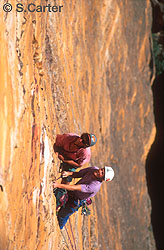
Above: Simon Mentz attempting pitch four Titan
(26, 120 meters), Dogface, Blue Mountains. Photos By Simon Carter.
Q: I understand you had something on an
epic fall in the Glasshouse Mountains. Can you relate this story for us?
I was leading the second pitch of a route called Slick Gazelle (21) on
Crookneck (QLD). Crookneck is a spectacular volcanic plug consisting of
refrigerator sized blocks stacked precariously on top of each other. I was
delicately bridging past one of these refrigerator blocks when it
separated with the cliff. I rode it for about twenty feet until my last
piece of protection (a 3 RP) held me. The block continued its way, gashing
my knee, slashing one of my ropes and narrowly missing Jared McCulloch who
was on a hanging belay. It hit the ground and rolled down the hill cutting
a huge track in the scrub below.
Q: Any another epics, near death or
otherwise?
The climb we did the previous day was pretty frightening also. It was on Tibrogagen and called Out of the Blue and Into the Black (24). I remember clipping this rusty peg on the traverse and when I got above it, the eye of the peg snapped off and it slid down the rope. Then as we tried to pull the lip, a huge barrage of rocks started pouring down from above. Some hooligans at the top were trundling them off. It must have lasted twenty minutes. We never caught the culprits. I think we would have strangled them if we had.
Iíve had a few near misses in my
time, but one that sticks in my mind involved rigging an abseil for a
school group at Camels Hump. I went to clip into my safety rope at the
cliff top and lean back at the same time. The loop missed my screwgate
karabiner and I found myself windmilling at the top of the cliff before I
finally teetered back to safety. I was pretty lucky.
Q: What's the story with Dog's Knob (26)
at Corruption Wall in Tasmania? It's described as a "way steep,
magnificent line" that you originally bolted but the FA fell to John
Fisher.
I wouldnít call it a magnificent line. It is pretty small cliff. It was
simply a matter of bolting something I couldnít get up. That wasnít
unusual for me.
Q: The three-star classic Mr Joshua (26)
on Taipan Wall was originally bolted by Scott Camps who let you and Jared
McCulloch "have a play on it". What was the result of that?
Iíve always wondered how Scott felt about that, missing out on establishing one of the best routes in the country. Scott left on an extended holiday shortly after bolting the line and told Jared and I that we could Ďhave a play on ití. Given that neither of us had climbed much harder than 22/23, I assume Scott didnít consider us a threat. It was only after Jared and I had spent a month climbing in NSW and QLD that we decided to return to Victoria to attempt the line. Jared was obsessed. I distinctly remember a conversation one evening when myself and another friend (Andrew Eastaugh) were talking about girls and all Jared wanted to talk about was Taipan Wall.
Our first attempts saw us battle to the crux but we were quite freaked by the exposure. We were also attempting it yo-yo style which meant we didnít know what lay above. Although I was first to work out the crux, Jared on his next shot pulled out all the stops and not only climbed through the crux but then climbed all the way through to the belay. I followed the pitch with numerous rests and couldnít believe how sustained it was.
Iím sure Scott must have been
pissed off when he found out. Although we had his permission to jump on
his project, no one had considered the possibility that one of us might
actually do it. Scott handled it pretty well though.
Q: We've talked a lot about FA's, but
what are some of the more memorable or satisfying repeats you've done?
 At Mt Arapiles I was very content to fall my way up Denim (26), Anxiety
Neurosis (26), Station to Station (25) and Undertaker (25), simply because
I recall seeing these routes on my first visit to Arapiles and they looked
outrageous. To climb them myself was beyond my wildest expectations.
At Mt Arapiles I was very content to fall my way up Denim (26), Anxiety
Neurosis (26), Station to Station (25) and Undertaker (25), simply because
I recall seeing these routes on my first visit to Arapiles and they looked
outrageous. To climb them myself was beyond my wildest expectations.
Iíve thoroughly enjoyed my Sydney Sea Cliff experiences, climbing such routes as Plunging Necklines (22), The Fear (17), Lost in Space (17), Swingtime (20), Duelling Biceps (23), Boyzone (23), Acute Wot (21), Cruise or Bruise (20). Credit needs to go Mike Law and Greg Child who not only developed the Sea Cliffs, but recorded their experiences, thoughts and feelings with some brilliant articles and guidebooks. I liken them to artists who have gone off on some strange tangent while the rest of the climbing population follow the norm.
Iíve also got to say that making
the second ascent of one of the Twelve Apostles with a group known as the
Wasters (a motley crew whose climbing aspirations had degenerated into an
orgy of drugs and booze) was also very memorable.
Q: What's the hardest graded route you
ever led? Was it something that plagued you for years? How does this
compare with your most enjoyable/memorable climbing experience?
Iíve never climbed anything
harder than grade 26, although Iíve climbed quite a few routes at that
grade. My main problem is that I lack power and Iím hopeless at pulling
difficult moves. Iím not too concerned though as Iíve still been able to
climb a lot of terrific looking lines on a lot of great cliffs.
Q: Has your climbing taken you overseas
much? If so, which areas did you explore? Any memorable anecdotes?
Iíve done a handful of trips overseasÖ US, NZ, UK, Europe. I enjoyed
climbing in the UK because of the scene, the history and the variety of
climbs and also because they have some great pubs. When I was in Europe I
had the opportunity to climb the The Matterhorn via the Hornli Ridge,
which is the easiest route to the summit. Despite the fact that you share
the climb with fat American tourists getting guided up it, I still reckon
it is one of the best looking lines up one of the world's best looking
mountains.
I spent a month in Yosemite and
bumbled my way up the North West Face of Half Dome and El Capitan (The
Nose) with various partners. Our ascents were slow and arduous, but both
climbs were truly memorable experiences.
Q: When you were climbing at your
hardest, did you follow a training scheme? If so, can you briefly explain
it?
Iíve never followed a specific training scheme and Iíve never known much about training principles. If I had applied myself, I could have climbed a few grades harder, but for the amount of effort required I donít think I would gained that much extra satisfaction and I would have still been a pretty useless at climbing really hard routes. As it was I had no shortage of fantastic climbs to try in the grades I could climb.
When I was living in Melbourne
(before the advent of climbing gyms) I would traverse bluestone walls such
as Richmond bridge and later the freeway wall at Burnley (although I could
never get very far along that).
Q: Do you find being tall an advantage
in climbing?
Being tall is probably an
advantage on vertical and lower-angled climbs because you can stand on
your feet and use your full height to reach whatever. On steeper climbs it
is often lock-off ability which determines your reach. Being tall means
having longer levers that work against you. It also means being heavier. I
weigh 15 stone (95 kilos). That is a lot of weight to drag up steep
climbs.
Q: Do you have a preferred style of
climbing now-a-days? (Boulder/Sport/Trad/Aid/etc). What's your opinion of
sport climbing and the emergence of Matty Brooks in the early 1990s? What
are your thoughts on trad new routing and 'the meaning of it all'; now vs
the past, (style/shady tricks/what's acceptable) etc.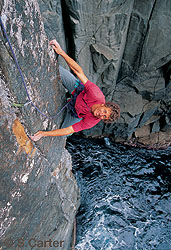
Well, if you really want to hear a few of my opinions on climbing, here goes...
Top-roping: Good fun and should treated more as an end in itself rather than as preparation prior to doing a pseudo lead on pre-placed gear.
Bouldering: Years ago I always thought of bouldering as activity removed from all the bullshit of climbing. The few boulderering devotees I knew seemed content to climb some of the most difficult problems imaginable without any hype. Nowadays bouldering seems to be more grade-focused, more equipment-based and more hyped than climbing ever was. And there seem to be more wankers doing it.
Sport Climbing: I thoroughly enjoy it, but itís amazing how at some sport crags you can slew your way through all the classics and afterwards you canít recall a single memorable moment or even a route name.
Development of new routes: Compared to fifteen years ago, we now have an immense collection of quality climbs of varying styles. I think the climbing fraternity needs to re-examine its approach to new routes. Climbers nowadays should think twice before pulling out the drill or wire brushing sections of cliff, just because they see a piece of unclimbed rock with a few good moves.
Iím pretty disappointed that Dave Jones and Gordon Poultney have added quite a few bolts to the Strolling Buttress at Mt Arapiles recently. This is a beautiful piece of rock where the previous existing routes largely followed natural weaknesses (although Chris Shepherdís variant start took the first step in this ugly direction years ago). Weíve now got variants on variants and the bolted lines start to take precedence. Whatís annoying is that other climbers have rapped some of these lines years ago and decided against doing them due to aesthetics of the cliff and their effect on the existing climbs. Given how easy it is to rig top-ropes on this particular cliff and the fact that top-roping these routes has become popular anywayÖ why not leave them as top-rope problems?
Matty Brooks: I never had
any real problem with Matty Brooks. My only comment was that if I could
climb as well as him I would be doing classics on Taipan Wall, not faffing
around on some of the pox cliffs he did.
Q: You're also a member (or president?)
of the "The Rams"
Aussie Rules has replaced climbing as my main focus over the last six or seven years. Iím fascinated by the different coordination required to play ball-sports and the transition of going from an individual sport to a team sport.
Playing football for Natimuk
though is like standing at the bottom of a difficult climb and never
getting off the ground. However the experience has helped me engage with
the non-climbing community in a very worthwhile way. Last year I was club
secretary, coach of the U16s, and ruckman in the senior team. We didnít
win a game all year, but the club is still in existence which is better
than a lot of small country football teams who have had to fold.
Aussie Rules is a great game and, believe it or not, it has a few
similarities to climbing (gnarly trad climbing to be more exact). Fear,
adrenalin and judgement are as much a part of football as in climbing, but
what I like about football is at the end of the day the siren goes and it
is game over. You accept the result. A lot of climbing nowadays is like
playing Ďtime-oní until one eventually succeeds. Itís almost as boring as
soccer.
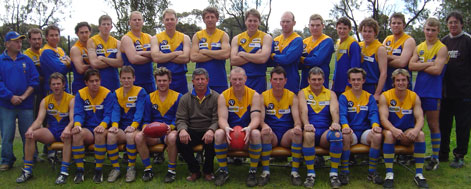
As for rounding up foreign climbers to playÖ we have had Scots, Bavarians,
Kiwis, Poms, Austrians, Irish, Dutch, Yanks all pull on the blue and gold
and play for the reserves team. The locals love watching the foreign
climbers play and are always impressed that they are out there having a
go.
Q: Tell us about this film you've been making about the Nati Football Team
titled "Rams to the Slaughter". Some have commented that it is the
funniest
film they have ever seen. Is this the start of a big career as a film
maker
perhaps?
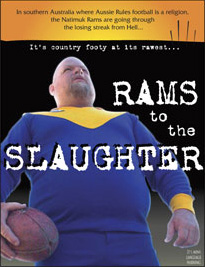 Rams to the Slaughter is a doco that I filmed while I was playing for the
club and it chronicles our team going through a horrendous losing streak.
It is a pretty raw production but it seems to entertain audiences even if
they donít have an interest in football. We had a screening in Natimuk
once where is it was the opener prior to an hour-long, super-slick
bouldering film (Colorado Daydream). Even though the audience were
predominantly climbers, they seemed to enjoy the footy film more due to
the fact that it had more of a story, more engaging characters, more
emotion and more humour (particularly when the club recruits UK climbers
Mike and Jamie to play in the reserves side).
Rams to the Slaughter is a doco that I filmed while I was playing for the
club and it chronicles our team going through a horrendous losing streak.
It is a pretty raw production but it seems to entertain audiences even if
they donít have an interest in football. We had a screening in Natimuk
once where is it was the opener prior to an hour-long, super-slick
bouldering film (Colorado Daydream). Even though the audience were
predominantly climbers, they seemed to enjoy the footy film more due to
the fact that it had more of a story, more engaging characters, more
emotion and more humour (particularly when the club recruits UK climbers
Mike and Jamie to play in the reserves side).
I think climbing is a difficult sport to capture, but I am keen to have a go at making some climbing films. Myself and Pat Ford started work on a historical doco about the climb Passport to Insanity. We have carried out interviews with the likes of Geoff Gledhill, Steve Monks, Louise Shepherd and of course Nyrie Dodd. Weíve also shot some footage of Dave Jones and Dave Musgrove attempting the route.
I would also like to make a film about the history of Australian climbing
from the mid-seventies to the mid-eighties, along similar lines to the
classic skateboarding flick Dogtown and Z-Boys. There is a great story to
be told from that era.
Q: While we're on the topic, what's it like living in Natimuk? Does the
small town country life and a close proximity to some of worldís top
climbing appeal? What is it that you do for a living, if I may enquire?
Living in Natimuk is greatÖ small yet diverse community, cheap housing,
and the worldís best crag only ten minutes down the road. And having
climbers visit from around the country and around the world adds to the
social scene. We also have the Grampians only an hour away and uncrowded
surf beaches only two hours away.
I make a living from guidebook sales, climbing instruction, graphic
design/illustration work, freelance writing, rigging and digital video. I
donít earn much, but I really enjoy my lifestyle. Things will change for
me later this year however, as I have just bought a building in the Main
Street of town and want to open a cafť.
Q: I've been told a rumour that you tired to convince some students that a
tin of baked beans would make good slung pro while teaching on a Climbing
Instructors Association (CIA) course recently?
I donít recall telling that to students, but they might have asked me
about an incident years ago when I led the first pitch (the grade 20
off-width) on Passport to Insanity using a modified baked bean tin to
protect myself. We had forgotten our big cams, and I was so keen to do the
route that I made up my own piece of gear using two empty tins with a rock
in the middle. I carried it up in an extra chalkbag, wedged it in the
crack and slung it. Fortunately I didnít fall on it.
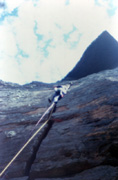
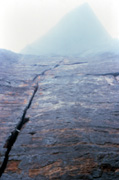


Above Left: Simon Mentz leading P1 of Passport To Insanity (27).
Above Middle: Simon's infamous Baked Ben Can for protection in P1
crack of Passport. Above Right: Chris Cope leading through the rood
pitch of Passport To Insanity (27) with Simon belaying.
Q: Could you relate the story behind the naming of your climb The
Beckoning
(26) at Bundaleer?
I donít want to bore you with the details, but it is to do with a holiday
fling which resulted in me following this particular girl to other side of
the globeÖ to no avail. Gordon Poultney came up with the name. It was very
appropriate.
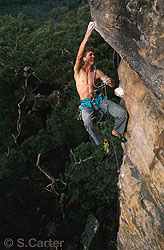
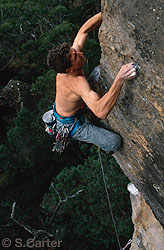
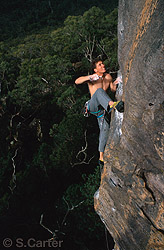
Above: Simon Mentz succumbing to the
lure of The Beckoning (26) at Bundaleer in The Grampians, Victoria,
Australia. Photos By Simon Carter.
Q: What is your favourite crag in Victoria and Australia in general? Do
you have a favourite route of all time? What is the most under-rated
Victorian crag?
Favourite crag: You canít beat Mt Arapiles. Itís got everything.
Favourite route: The Totem Pole (The Free Route). Unique situation and
great climbing.
Most under-rated Victorian crag: Richmond Bridge (a bluestone wall in
Melbourne). A great training wall for intermediate city climbers.
Q: Have there been other climbers that have inspired you throughout your
climbing life? If so, who and why? I understand that you used to climb
with Louise Shepherd a lot. Was that inspiring? Any interesting stories?
There are thousands of climbers that I have found inspiring. Itís usually people doing imaginative and interesting climbs, or doing routes in good style. But I am also inspired by climbers that contribute to climbing in other waysÖ by writing thought-provoking articles, producing inspiring guidebooks or magazines (or web pages), organising environmental projects, re-equipping climbs sensiblyÖI could talk for hours about various people in the climbing scene. These are just a few comments on a few peopleÖ
Louise ShepherdÖ well I was certainly in awe of her when I started climbing (and I had the hots for her!) so it was a bit of buzz when we teamed up. I am still amazed at some of the routes she on-sighted (placing gear) back in the early eighties. Some climbers have just got that extra something and she had it.
Climbing with Ian Vickers (UK) was both inspiring and demoralising at the same time. His ability to on-sight naturally protected routes at the most difficult grades was unbelievable. Although he set a standard that made my efforts seem pathetic, he inspired me to improve within my own framework.
Iíve always loved the routes that Mike Law has put up. They appeal on so many levels. His writing and guidebooks have also enriched the sport considerably. Iíve had so many great experiences on Claw routes that itís hard to imagine what Australian climbing would have been like without him.
I feel Jon Muirís attempts to on-sight solo Trojan (25) rate as one of the
most impressive efforts in Australian climbing. Jonís uncompromising
approach symbolises everything I admire in climbingÖ judgement,
commitment, skill and amazing control. To downclimb from three-quarters
height and walk away is a lot more impressive than sussing it out with a
rope and then claiming a solo ascent.
Q: So what does your future hold in terms of climbing? Do you have any
'secret' areas still awaiting development?
Iíd like to do a bit more mountaineering. I really believe mountaineering (depending upon your objective and the style you do it in) is the essence of climbing. However I also think mountaineering is ridiculously dangerous. Iím happy to wait a few more years before wiping myself out in the hills.
Photos From Simon Mentz's Collection:
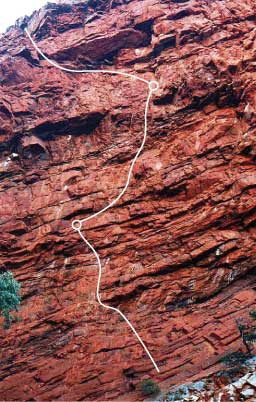


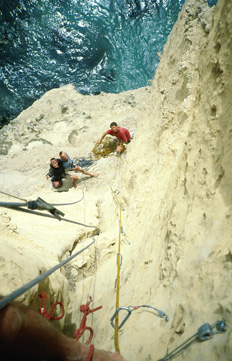
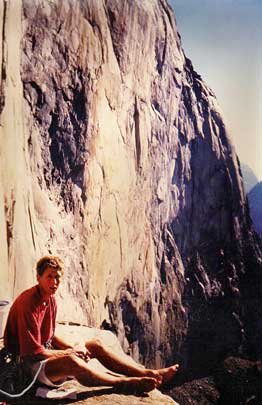
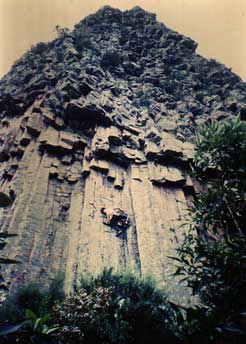
Above Left: A young Simon Mentz at El Cap. Above Right:
Crookneck.
Further Reading: ![]()
Totem Pole - Photos of Simon Mentz on Tasmania's Totem Pole over on
Simon Carter's website.
Araps & Gramps Select Guides - Guide books authored by Simon Mentz &
Glenn Tempest available on the Open Spaces Photography website.
Home | Guide | Gallery | Tech Tips | Articles | Reviews | Dictionary | Forum | Links | About | Search
Chockstone Photography | Landscape Photography Australia | Australian Landscape Photography
Please read the full disclaimer before using any information contained on these pages.
All text, images and video on this site are copyright. Unauthorised use is strictly prohibited.
